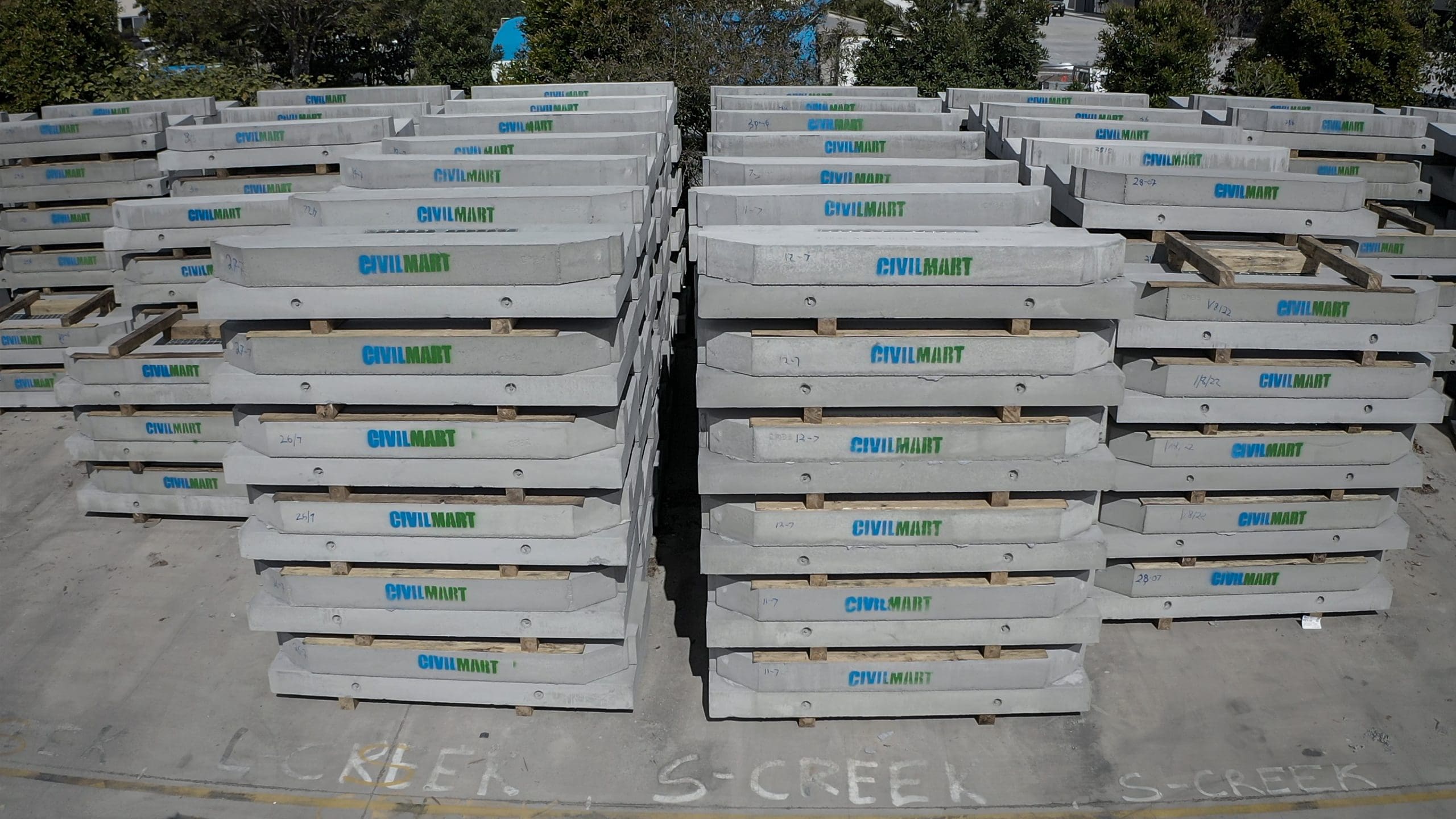A Guide to Concrete Lintels
Lintels are an essential part of our transport infrastructure. In this comprehensive guide to concrete lintels, we cover everything you need, or want, to know about them. What they are… what they do… why they’re necessary… We also explain the different kerb and concrete lintel types and the roles they play on our highways and byways
What is a Concrete Lintel?
For most people, lintels are the horizontal supports above doorways and other openings in buildings! They help to distribute the weight above the opening to the walls on either side of the opening. However, you’ll also find lintels in stormwater drainage systems where they perform a similar, and pivotal, role.
More specifically, concrete lintels, or kerb inlets, are structures with openings built into roadside kerbing that facilitate stormwater runoff and drainage into underground stormwater pits or drains. They are typically placed over the entrance of pits or drains installed adjacent to the road. The pits have either an access grate within the lintel structure, or a steel cover set behind the lintel.
Concrete lintels are particularly important in stormwater drainage because they:
- Protect stormwater inlets and the surrounding kerbs from structural damage caused by overhead weight,
- Help keep the inlets open and clear,
- Facilitate the flow of water into the underground stormwater system, preventing surface pooling, and flooding.
- Act as a protective barrier against water flow, protecting the infrastructure around the opening and the drainage system itself from erosion.
- Keep drainage systems, overhead traffic, and pedestrians, safe.
- Can enhance kerb aesthetics.
Our concrete precast lintels are designed and reinforced to provide critical structural support for the other components of the drain. This helps protect these structures and ensures their longevity and integrity.
Concrete Lintel Uses
The main uses and roles of concrete lintels in stormwater drainage systems include:
- Support for stormwater inlets: lintels like our RMS Kerb Lintels and Standard Council Kerb Lintels provide structural support for kerbside stormwater inlets. These inlets are installed along roads and footpaths to facilitate runoff into underground drainage systems. The lintels act as a ‘door frame’. They span the inlet opening to protect its structural integrity, and prevent it from collapsing or distorting under the weight of overhead traffic or heavy rain.
- Maintain efficient drainage: lintels help maintain drainage system efficiency, which prevents surface flooding, and pooling. They protect stormwater inlets from structural damage that may impede their efficiency, help keep the inlets open and clear, and facilitate the unobstructed flow of water into the underground stormwater system.
- Protect surrounding structures: reinforced concrete precast lintels are designed to distribute weight evenly and reduce the stress on kerb and road structures around stormwater inlets. This helps protect the surrounds from damage like cracking and structural collapse.
- Reduce erosion around stormwater infrastructure: lintels bear the brunt of water flow and prevent erosion around the surface of stormwater drains and inlets.
- Improve kerb aesthetics and safety: lintels are produced with the same profiles as kerbs in order to produce a seamless and aesthetically pleasing finish. Our one-piece highflow lintels are particularly well suited for this purpose as they combine the lintel and storm water pit inlet grate as a single unit.
Types of Concrete Lintel
Concrete lintels are manufactured to match the profiles of the main classes of kerb in use, namely barrier and mountable. These names refer to the shape and function of the kerb, and of course its corresponding lintel. The variations i.e. semi-barrier, semi-mountable etc also come in different designs mainly related to curve angles, height, width and so on.
States also have their own kerb and lintel specifications. Civilmart for example produces B2 barrier lintels and rollover lintels that comply with both AS 2876-2000 and Vicroads standards. The standard council kerb lintels and RMS lintels (New South Wales Roads and Maritime Services) are for use on NSW roads and comply with the applicable standards in that state.
With that in mind, here is a basic explanation of the main kerb and concrete lintel types and their common applications.
Barrier Lintels
A barrier curb and its corresponding lintel have a high (~150mm) straight or steep faced profile to deter people from driving over it. Barrier kerbs and barrier lintels are commonly used in built-up areas:
- Alongside footpaths and shared use paths with a lot of pedestrian and/or bicycle traffic,
- At bus bays,
- Along low speed arterial roads (<70km/h) to stop mid-block turns,
- Along high safety risk sections of road – high traffic volumes, high % of heavy vehicles, significant crash history etc – where two-way traffic needs to be separated for safety.
Semi-Barrier Lintels
Rollover or semi-barrier lintels and kerbs are the same height as barrier kerbs but have either an additional angled face along the top, or a more angled face than a barrier lintel. This face is designed to deflect vehicles under normal driving conditions whilst allowing safe (slow) access over the kerb if necessary.
Semi-barrier lintels and kerbs are often used in low-pedestrian areas or where vehicles (maintenance / emergency etc) need to be able to drive over them. However, like barrier lintels and kerbs, their use is generally restricted to <70km/h roads.
Note: the use of semi-barrier and barrier lintels and kerbs on roads with speeds >70 km/h is generally not recommended because they can cause roll-overs or a vehicle to become air-borne if hit at speed.
Mountable Lintels
A mountable kerb and mountable lintel has a much lower profile to allow vehicles to drive over them without damaging the undercarriage or causing the driver to lose control. They may or may not have either a curved or angled face. You’ll typically see these lintels and kerbs used:
- At intersections, roundabouts, and small corner islands,
- To delineate sections of road where the slope of the road surface and that of the adjacent parking strip or shoulder run in opposite directions,
- Where large vehicles may need to run over the kerb in order to navigate a section of road (tight corners, roundabouts etc),
- Where emergency vehicles are probably going to have to cross the kerb to get through heavy traffic,
- Along grassed edges of bitumen cycle and pedestrian paths to protect the edges from erosion and grass encroachment.
Semi-Mountable Lintels
Semi-mountable lintels and kerbs sit somewhere between barrier and mountable kerbs in terms of height making them ‘semi’ difficult to mount. Like mountable kerbs, they have a ‘vehicle-friendly’ curved or angled face.
High-Flow Lintels
High-flow lintels are a more specialised type of lintel for use in areas where there are large volumes of stormwater runoff. They typically have a higher profile than other types of lintels, with a larger opening, a built-in gutter, and storm grate.
Civilmart’s high-flow lintels are a one-piece unit with a profile height of 230mm (vs the standard 150mm of barrier lintels). They are made from reinforced concrete to AS 2876-2000 and various state standards and are ideal where a one-piece unit is a more practical option for stormwater pit inlet construction.
Note: The use of kerbs and lintels per se is generally not recommended on rural roads other than at junctions, bridges, cuttings etc where there is a need to control water runoff and manage traffic movement.
Why Choose Civilmart for Your Concrete Lintel
When it comes to all things concrete and drainage-related, make Civilmart your go-to supplier. Our high-quality reinforced concrete precast lintels are structurally superior and thoroughly road-tested. They comply with the national AS 2876-2000 standard plus all applicable Vicroads and NSW RMS standards. Combined with our reputation for exceptional customer service and with one of the most experienced teams in the business, Civilmart is the obvious choice of partner for all your stormwater drainage needs. Contact us for more information about our concrete lintels sizes, specifications, types, and uses.
Join the Civilmart family
Stay up to date with latest product releases, newest industry innovations and more!


